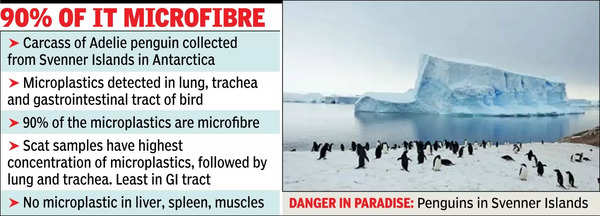KOLKATA: Microplastics have invaded even the remotest parts of our planet, with Indian researchers discovering particles measuring 20-100 micron in the lung, trachea and gastrointestinal tract of Adelie penguins from Svenner Islands in Antarctica.
The study, samples for which were collected during the 39th Indian Antarctic Expedition of 2019-2020, has sent alarm bells ringing among environment scientists and raised concerns about the impact of pollution on the penguin population of Antarctica.

The findings were recently published in Science of the Total Environment, a prestigious weekly international peer-reviewed scientific journal covering environment science.
Calcutta University‘s environmental science department head Punarbasu Chaudhuri, who led the study, said, “The study is unique because for the first time it reports the presence of microplastics, predominantly fibre-type, in various organs and tissues of Adelie penguins, which are prominent bio-indicators of the Antarctic ecosystem.”
Chaudhuri, along with Prabir Ghosh Dastidar from Polar Science division, ministry of Earth Science, had collected an adult penguin carcass from a spot near India’s Bharati Research Station in Antarctica for the study.
Antarctica’s ecological health alarms scientists
The researchers collected samples from various organs of the dead penguin and gathered scat samples from the surrounding area and preserved them for analysis in India. The examination was conducted at Calcutta University, while the microplastic characterisation was performed at CSIR-National Institute of Oceanography, Goa, under the supervision of principal scientist Mahua Saha.
Prabir Ghosh Dastidar said, “The intimate association between adult penguins and their chicks, with adults feeding collected food to the young, provides a critical area for studying the effects of microplastic pollution in penguins. It raises concerns about the transfer of emerging pollutants to young ones, directly posing a threat to the survival of this endemic species of Antarctica.”
Jadavpur University environmental studies assistant professor Subarna Bhattacharyya said the scat samples showed the highest concentration of microplastic, followed by the lungs and trachea, while the gastrointestinal tract had the least.
According to the researchers, penguins ingest microplastic through their prey and environment. Saha explained that 90% of the microplastic were microfibres, with high concentrations in scat indicating poor digestion. Their presence in respiratory organs suggests airborne transmission, with thinner fibres posing increased health risks through blood circulation.
Shrayan Bhattacharjee, a Zoological Society Kolkata intern and CU research scholar Praveen Tudu said while no microplastic were found in the liver, spleen or muscles, further research was needed to understand contamination implications in the Antarctic ecosystem.
The findings have alarmed scientists, as Adelie penguins are crucial indicators of Antarctica’s ecological health. Former JU oceanography professor Sugato Hazra warned: “It is alarming how microplastic accumulation has been found in Adelie penguins. Unless source contributors can be controlled or restricted in the land itself, the penguins of Antarctica cannot be saved.”
This post was originally published on here







